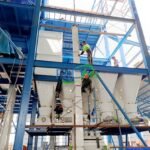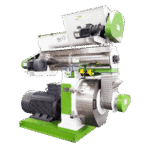Introduction
Broiler production is one of the most dynamic sectors in the poultry industry, driven by the global demand for affordable, high-quality protein. Success in broiler farming hinges on efficient feed management, and a poultry feed pellet machine serves as a cornerstone in this effort. This article explores how pellet machines are revolutionizing broiler production by improving feed conversion, accelerating growth rates, and reducing operational costs.

1. Broiler Feed Requirements: Precision Matters
Broilers are genetically optimized for rapid weight gain, but they require precisely balanced nutrition to achieve their growth potential. Key feed elements include:
- Protein: For muscle development
- Energy (Carbohydrates & Fats): To fuel growth
- Minerals (Calcium, Phosphorus): For bone health
- Vitamins: For metabolism and immunity
The challenge lies in delivering these nutrients efficiently while minimizing feed waste and maximizing absorption.
2. Pellet Feed vs. Mash Feed for Broilers
Traditionally, many broiler farms used mash feed due to its low initial cost and ease of preparation. However, pellet feed produced via Poultry Pellet Making Machines offers superior advantages:
| Feature | Mash Feed | Pellet Feed |
|---|---|---|
| Digestibility | Moderate | High – heat and compression improve digestibility |
| Feed Wastage | High – easily scattered | Low – compact and uniform |
| Bird Preference | Less palatable | More palatable and consistent |
| Conversion Efficiency | Lower FCR (1.9-2.2) | Higher FCR (1.5-1.8) |
| Labor Involved | High – frequent cleaning | Lower – neater feeding process |
Broiler performance improves noticeably when pelletized feed is introduced.
3. How Poultry Feed Pellet Machines Work
To produce pellet feed, poultry feed pellet machines follow a structured process:
- Grinding: Raw materials (corn, soybean meal, fishmeal, etc.) are ground to fine particles
- Mixing: Ingredients are blended with vitamins, minerals, and additives
- Conditioning: Steam or moisture is added to soften the feed
- Pelletizing: The feed is pressed through a die under high temperature and pressure
- Cooling: Pellets are cooled to stabilize structure and prevent spoilage
Each stage enhances the nutritional delivery and quality of the final feed product.
4. Benefits of Pellet Machines in Broiler Operations
a. Improved Feed Conversion Ratio (FCR)
Pellet feed is more digestible and reduces feed wastage, helping broilers convert feed into body weight more efficiently. A 5–10% improvement in FCR can significantly reduce production costs.
b. Uniform Growth Across Flock
With consistent pellet sizes and nutrient distribution, all birds in the flock receive similar nutrition, minimizing weight variance at harvest.
c. Faster Growth Cycles
Studies show broilers fed with pellets can reach market weight 3–5 days earlier than those fed with mash, boosting turnover and profits.
d. Reduced Labor and Management Stress
Pellet feed is easier to handle, store, and distribute. There’s less dust, less feed loss, and cleaner housing environments, translating into less labor and higher biosecurity.
5. Choosing the Right Pellet Machine for Broiler Feed
When selecting a poultry feed pellet machine for broiler operations, consider the following:
| Criteria | Details |
|---|---|
| Production Capacity | Match with daily feed needs: 500 kg/h to 5 tons/h for larger farms |
| Type of Die | Ring die (high-volume) vs. flat die (lower-volume, economical) |
| Conditioning Unit | Ensures better gelatinization for broiler digestibility |
| Energy Source | Diesel, electric, or hybrid – based on local availability |
| Durability of Rollers & Die | Hardened steel is ideal for long-term use |
| Ease of Maintenance | Access to local service and availability of spare parts |
Proper sizing and maintenance are critical to ensure consistent pellet quality and output.
6. Cost-Benefit Analysis for Broiler Producers
Initial Investment
- Small farm unit (flat die): $1,000–$3,000
- Commercial unit (ring die): $10,000–$50,000+
- Ancillary equipment (grinder, mixer, cooler): Add 20–30% more
Operational Cost Savings
- Reduced feed wastage (10–15%)
- Improved FCR (savings of up to 300 g of feed per bird)
- Lower labor costs
- Better health outcomes reduce medication needs
ROI is typically achieved within 12–18 months for mid-sized broiler operations.
7. Practical Tips for Pelletizing Broiler Feed
- Optimize Moisture Content: 16–18% is ideal during pelletizing
- Control Temperature: Keep die temp between 75°C–90°C for best results
- Use Binding Agents if Needed: For certain ingredients like rice bran
- Cool Pellets Immediately: Prevent clumping and spoilage
- Store Pellets Properly: Use airtight containers or bags in cool, dry areas
Small adjustments in processing can result in major improvements in pellet quality and broiler performance. (Related post:https://www.pellet-richi.com/feed-pellet-machine/)
8. Case Study: Broiler Farm in Bangladesh Increases Profit by 22%
A commercial broiler farm with 10,000 birds in Gazipur, Bangladesh, installed a 2 ton/hour poultry feed pellet machine:
- Switched from purchasing commercial feed to in-house pelletizing
- Customized feed based on seasonal nutritional needs
- Feed cost reduced by 17% and average harvest time reduced by 4 days
- After one year, net profits increased by 22%
This demonstrates the scalability and effectiveness of integrating a pellet machine into broiler production systems.
9. Supporting Technology and Automation
To further streamline broiler feed production, many farms integrate:
- Automated batching systems
- Ingredient silos
- Conveyor systems
- Pellet coolers and crumbler units (for younger birds)
These additions can boost throughput and reduce manual labor in medium to large broiler farms.
Conclusion
For broiler producers seeking a competitive edge, the poultry feed pellet machine offers a pathway to greater efficiency, profitability, and control. By enabling the production of high-quality, consistent feed, these machines improve growth rates, reduce wastage, and lower dependency on external suppliers.
As the demand for broiler meat continues to rise, investing in feed pellet technology is not just a smart decision—it’s a strategic move toward sustainable and profitable poultry farming.

